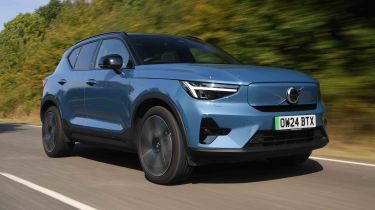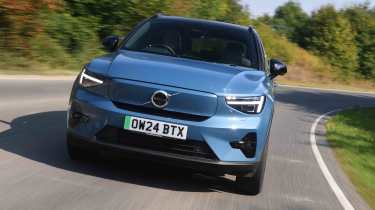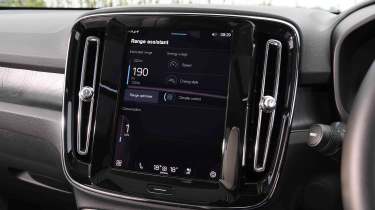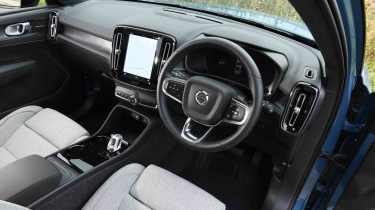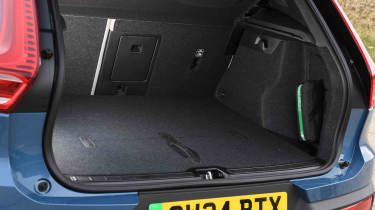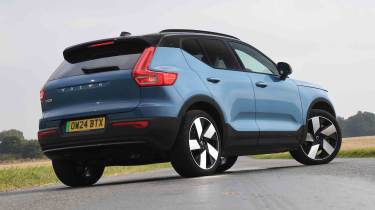Volvo EX40 review
A new name has had little effect on the capability of the Volvo EX40 premium SUV

Is the Volvo EX40 a good car?
Introducing the Volvo EX40 was a necessary rebrand that brings the Swedish firm’s medium-sized electric SUV into line with the EX30 and EX90 that now bookend Volvo’s electric line-up. Another benefit is that Volvo can now market and sell the car as its own entity, separate from the petrol-powered Volvo XC40, which will continue in production for the time being.
Aside from the badge on the tailgate, not much else is different on the EX40. There are four power outputs and three battery sizes to choose from, while prices start at around £46,000. For reference, the XC40 kicks off for £10,000 less, while the more sportily styled Volvo EC40 (another rebadge, this time of the C40) is the same price as the EX40, but misses out on the entry-level Core trim offered here.
| Key specs | |
| Fuel type | Electric |
| Body style | Five-door compact SUV |
| Powertrains | 69kWh battery, 1x e-motor, rear-wheel drive 78kWh battery, 1x e-motor, rear-wheel drive 82kWh battery, 2x e-motors, four-wheel drive |
| Safety | Five-star Euro NCAP (2021) |
| Warranty | 3yrs/60,000 miles |
How much does the Volvo EX40 cost?
Separating the Volvo EX40 from the XC40 range hasn’t impacted pricing, with the range starting from around £46,000. There are four powertrain options available: the 69kWh Single Motor model, a 78kWh Single Motor Extended Range, the 82kWh Twin Motor, and the Twin Motor Performance with the same battery, but a bit more power. The Single Motor cars are rear-wheel drive (which arrived when the electric XC40 was updated in 2023), while Twin Motor models have four-wheel drive
That starting price is for the Core model with the standard battery. It’s the only EX40 that comes with that pack, but we’d recommend spending the £1,700 or so needed for the Extended Range version with around 50 more miles of range. That’s the model with the longest range, albeit by only a few miles over higher-spec cars, but choosing the base model is no hardship, because the EX40 is well stocked with standard kit.
There’s two-zone climate control, a nine-inch infotainment touchscreen with Google operating system and Google Maps navigation plus Apple CarPlay, a 12.3-inch digital instrument cluster, automatic LED headlights with active main beam, heated mirrors and front seats, keyless entry and starting, auto lights and wipers, rear parking sensors and reversing camera, a powered tailgate, and Volvo’s long list of safety kit.
You need to spend an extra £6,500 for Plus trim, and importantly, this adds a heat pump that helps take a load off the drive battery in colder temperatures to maintain driving range. Also included are a heated steering wheel and outer rear seats, an electric memory driver’s seat, Volvo’s Pilot Assist semi-autonomous driving, larger wheels, a black contrast roof finish and suede-effect interior trim.
Another £4,000 is needed for the Ultra model, which adds adaptive LED headlights and cornering foglights, a 360-degree camera system, even larger alloy wheels, a panoramic sunroof, different upholstery, an electrically adjustable passenger seat and a 12-speaker Harman Kardon surround sound system.
Volvo is currently offering Black Edition versions of Plus and Ultra trims. They come in Single Motor Extended Range or Twin Motor Performance specs (which is currently the only way to get the latter powertrain), with Onyx Black paint, all of the car’s exterior chrome deleted (including the diagonal slash across the grille) and gloss-black 20-inch alloys. Prices start from £55,000 for the Single Motor Plus Black Edition, rising to £63,000 for the Ultra Black Edition in Twin Motor Performance guise.
Electric motors, performance & drive
There are standard and Extended Range battery options available with the Single Motor powertrain. The former has a 69kWh pack, while the latter features a 78kWh unit, and their rear-mounted electric motors have power outputs of 235bhp and 249bhp, respectively. The power difference is there to compensate for the extra 42kg of weight that the Extended Range car carries, and both can sprint from 0-62mph in 7.3 seconds.
The Twin Motor version has a 254bhp rear-mounted unit that’s joined by a 148bhp motor up front for a combined total of 402bhp, while the battery increases to 82kWh. This four-wheel-drive model can sprint from 0-62mph in a sports-car-baiting 4.8 seconds. But if that isn’t fast enough for you, the Performance version bumps the power up to 436bhp and can accelerate from 0-62mph in 4.6 seconds.
| Model | Power | 0-62mph | Top speed |
| EX40 Single Motor | 235bhp | 7.3 seconds | 112mph |
| EX40 Twin Motor | 402bhp | 4.8 seconds | 112mph |
| EX40 Twin Motor Performance | 436bhp | 4.6 seconds | 112mph |
While the EX40 has the firepower to be rapid in a straight line, the chassis is geared more towards comfort than sharp handling. The EX40’s upright body gives you a tall seating position that allows you to place it on the road precisely, while the flat bonnet only slopes away slightly, so you know where the front of the car is. And if you can’t judge that, front and rear parking sensors and a reversing camera are standard on all models.
Light steering and a tight turning circle – albeit not as tight as in some rivals with rear-mounted electric motors – mean low-speed manoeuvres are easy. A punchy power delivery means there’s plenty of get-up-and-go at the lights, although hard acceleration sees the car rear up on its relatively soft suspension as its weight transfers backwards.
At faster speeds, the electric motors still offer a decent amount of power, especially in Twin Motor guise, but the chassis doesn’t have a sporty enough set-up to keep pace, with some pitching under acceleration and braking. It’s not unnerving, though.
The soft set-up also compromises the EX40 in corners, where some body roll makes its presence felt. There’s still plenty of grip, but this and a light steering setup mean you’re unlikely to want to explore the limits of the car’s handling further. However, that’s not what this car is about, and it’s better to enjoy the ride comfort instead.
Bumps and lumps are dealt with well, although the larger 20-inch alloys offered on higher-spec versions amplify the shocks that enter the cabin, and there’s a bit more fidget from the suspension with big wheels fitted.
With plenty of power on tap, getting up to motorway speeds is a breeze, and there’s still lots of urge left once you’ve reached the national limit. Cruising comfort is reasonable, although tyre roar and a whistle around the door mirrors do develop when you’re approaching 70mph.
Range, charging & running costs
A more efficient rear-mounted motor set-up was introduced in 2023 to help the EX40 deliver competitive range figures.
The best performer in the EX40 line-up is the Single Motor Extended Range variant, which has a claimed maximum range of 343 miles from its 78kWh battery. Next up is the Twin Motor, which can travel up to 332 miles on a full charge of its 82kWh pack, while the Performance version has a 326-mile maximum. Plump for the standard 69kWh battery in the Single Motor model, and there’s a range of up to 296 miles on offer.
It’s worth noting that the Core trim level doesn’t come with a heat pump, so this variant’s range will see a bigger reduction in cold weather when compared with higher-spec models in the line-up. It’s not even available as an option, so you’ll have to spend around £6,000 extra to upgrade to Plus trim.
The maximum DC charging speed varies depending on which battery you choose. The smallest one has a maximum rate of 135kWh, while the Extended Range bumps this up to 155kWh. It takes the same amount of time to get these batteries from 10-80 per cent, at 33 minutes. The bigger Twin Motor battery has a peak charging speed of 205kW, and takes 28 minutes to go from 10-80 per cent charge.
Competitive list prices are to the benefit of company car tax, which is rated at two per cent for the 2024/25 tax year. That means the Single Motor versions of the EX40 dip below the £200 mark in annual contributions for lower-rate taxpayers.
Insurance cover costs for the EX40 are on a par with electric SUV rivals. The bandings start at Group 35 and rise from there, with trim levels and power outputs both bumping up the costs. At the top of the range, the Ultra Performance model sits in group 40.
The EX40 has poorer residual values than some of its closest rivals. Whether that’s to do with the car’s age, or the fact the name has changed from XC40 to EX40, we can’t say. However, residuals in the lower 40 per cent region are behind those of other premium electric SUVs.
| Model | Battery size | Range | Insurance group |
| EX40 Single Motor | 69kWh | 296 miles | 35 |
| EX40 Single Motor Extended Range | 78kWh | 343 miles | 36 |
| EX40 Twin Motor | 82kWh | 332 miles | 42 |
Design, interior & technology
The upright exterior is carried over to the cabin, where the dashboard carries on with a vertical theme. There’s a portrait-style touchscreen and four upright air vents across the dash, but the central display looks small when compared with the vast layouts offered by rivals. At least the black plastic is broken up by some silver material, while the charcoal-coloured fabric seats give the cabin a lift.
The physical switchgear feels solid to use, especially the small rotary knobs on the air vents and the large volume control just below the screen, but we just wish there were physical controls for the climate, too. Another highlight is the stubby drive selector, which has a pleasingly short throw.
Build quality is good, and everything feels solid, while neat touches, such as the partial flock lining for the front door bins, add to the premium character of the EX40.
When it was launched, the then-XC40’s nine-inch portrait display was a break from the norm. Today, it looks small in comparison with fresher rivals, although nothing is dated about the Google operating system that it uses.
There are a number of apps on offer, and if you have a Google account, you can sign in and sync your information with the car – a handy feature if you want to transfer mapping details to the car’s system. Apple CarPlay is also included, but it’s a wired set-up.
In addition to the main display, there is a large digital instrument cluster for the driver. This offers clear information, although the controls via the multifunction steering wheel are a little vague. There are no pictograms on the steering wheel buttons, so it’s best to get familiar with the button layout and how it all functions before setting off.
Boot space, comfort & practicality
| Dimensions | |
| Length | 4,440mm |
| Width | 1,938mm |
| Height | 1,651mm |
| Number of seats | Five |
| Boot space | 410-1,286 litres |
The EX40 competes in a market where style takes priority over outright practicality, but there’s just enough space for a family of four and their luggage.
There are no issues with space up front, while the driving position and large windows offer a clear view of your surroundings. A wide range of adjustment in the seat and steering wheel means it’s easy to get comfortable, while Volvo’s seats are famous for offering long-distance comfort.
On the downside, front door bins are narrow. On the more positive side, they are flock-lined to stop items from rattling about. There’s a deep cubby just ahead of the drive selector for your mobile phone. The central armrest bin is narrow but deep, and there’s a small lidded cubby just ahead of it and twin cup-holders next to the drive selector.
The back seats are a little narrow, so sitting three abreast will be tight, while the shallow seat bases and high-set floor mean under-thigh support is lacking somewhat. The fixed rear headrests also tilt your head forward a little, while adding the optional panoramic sunroof eats into headroom slightly.
Storage in the back is fair, with the hard-backed front seats featuring elasticated nets, while the door bins are similar to the fronts, with a flock lining included. Air vents and charging sockets are also included in the back, while small trinket trays are located at either side of the rear seats.
There are two sets of Isofix mounts on the outer rear seats that are easily accessible behind plastic covers. A third set of mounts features on the front passenger seat, but these aren’t quite as easy to reach, because they’re hidden at the base of the seat cushion.
The standard-fit powered tailgate opens to reveal a high loading lip, but the boot floor is level with the edge of the tailgate to help with sliding in heavier items. The floor itself is hinged to create a boot divider, while this also reveals a large well underneath for storing the charging cables.
The back seats have a 60:40 split, although there’s also a ski hatch for loading long, thin items. The EX40 has a small storage area in the nose thanks to the removal of the engine from the traditionally powered XC40, and at 30 litres, it’s big enough to carry a charging cable separate from the rest of your luggage.
Safety & reliability
Volvo is currently offering a Servicing plus Wear and Tear package as standard with the EX40. That means maintenance is included for three years or 60,000 miles. As well as topping up fluids and replacing filters, the Wear and Tear element sees the wiper blades, brake discs and pads replaced where needed.
Volvo’s three-year/60,000-mile warranty is par for the course in the premium sector. It can be extended by 12 months at extra cost, but can’t match the 10 years/100,000 miles of cover available to Lexus buyers. In addition to the standard warranty, the EX40’s drive battery is covered for eight years or 100,000 miles, although deteriorating battery capacity isn’t part of this policy.
The EX40 (nee XC40) has a five-star Euro NCAP rating, with an impressive 97 per cent score for adult occupant protection and 87 per cent for child occupant protection. All cars feature automatic emergency braking that can spot cars, pedestrians and large animals, while a lane departure system will intervene and steer the car back into the lane if it senses a potential collision with oncoming traffic.
Pilot Assist is Volvo’s semi-autonomous driving tech, and this comes as standard on Plus and Ultra models, while it’s an option on Core trim. This adds adaptive cruise control that can steer, accelerate and brake in slow-moving traffic, even bringing the car to a complete stop if necessary.
| Key standard safety features | Euro NCAP safety ratings |
|
|
Volvo EX40 alternatives
The compact premium electric SUV market is filled with a variety of rivals. From the German ‘big three’ are the Audi Q4 e-tron (also offered in EC40-aping Sportback guise), BMW iX1 and BMW iX2 and the Mercedes EQA (or seven-seat Mercedes EQB). Other options include the Lexus RZ and the top-selling Tesla Model Y - the latter being a very strong option in the class. The Volkswagen ID.4 is a slightly cheaper alternative, while the Polestar 2 shares tech with the EX40. Finally, the Genesis GV60 is an even further leftfield choice, but shares tech with the well-regarded Hyundai Ioniq 5, making it a great EV.
If you’re not ready to go full EV, Volvo no longer offers a plug-in hybrid version of the XC40 - it’s just sold with petrol engines now. However, if a PHEV appeals, options include the BMW X1, Alfa Romeo Tonale, Range Rover Evoque and Volkswagen Tiguan.
Frequently Asked Questions
When we tested the EX40 in Extended Range guise, it delivered an efficiency figure of 3.6 miles per kWh. This was in mild conditions and meant a range of 270 miles was on offer, around 70 miles short of the claimed best.
